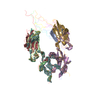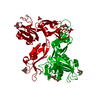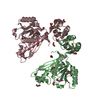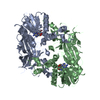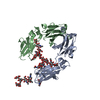[English] 日本語
 Yorodumi
Yorodumi- SASDDT4: Fc region of Immunoglobulin G1 (IgG1 Fc) (Immunoglobulin heavy co... -
+ Open data
Open data
- Basic information
Basic information
| Entry | Database: SASBDB / ID: SASDDT4 |
|---|---|
 Sample Sample | Fc region of Immunoglobulin G1 (IgG1 Fc)
|
| Function / homology |  Function and homology information Function and homology information complement-dependent cytotoxicity / complement-dependent cytotoxicity /  antibody-dependent cellular cytotoxicity / Fc-gamma receptor I complex binding / Classical antibody-mediated complement activation / Initial triggering of complement / immunoglobulin complex, circulating / IgG immunoglobulin complex / immunoglobulin receptor binding / FCGR activation / Role of phospholipids in phagocytosis ... antibody-dependent cellular cytotoxicity / Fc-gamma receptor I complex binding / Classical antibody-mediated complement activation / Initial triggering of complement / immunoglobulin complex, circulating / IgG immunoglobulin complex / immunoglobulin receptor binding / FCGR activation / Role of phospholipids in phagocytosis ... complement-dependent cytotoxicity / complement-dependent cytotoxicity /  antibody-dependent cellular cytotoxicity / Fc-gamma receptor I complex binding / Classical antibody-mediated complement activation / Initial triggering of complement / immunoglobulin complex, circulating / IgG immunoglobulin complex / immunoglobulin receptor binding / FCGR activation / Role of phospholipids in phagocytosis / antibody-dependent cellular cytotoxicity / Fc-gamma receptor I complex binding / Classical antibody-mediated complement activation / Initial triggering of complement / immunoglobulin complex, circulating / IgG immunoglobulin complex / immunoglobulin receptor binding / FCGR activation / Role of phospholipids in phagocytosis /  complement activation, classical pathway / complement activation, classical pathway /  antigen binding / FCGR3A-mediated IL10 synthesis / antigen binding / FCGR3A-mediated IL10 synthesis /  Regulation of Complement cascade / FCGR3A-mediated phagocytosis / B cell receptor signaling pathway / Regulation of actin dynamics for phagocytic cup formation / antibacterial humoral response / Interleukin-4 and Interleukin-13 signaling / blood microparticle / Regulation of Complement cascade / FCGR3A-mediated phagocytosis / B cell receptor signaling pathway / Regulation of actin dynamics for phagocytic cup formation / antibacterial humoral response / Interleukin-4 and Interleukin-13 signaling / blood microparticle /  adaptive immune response / adaptive immune response /  extracellular space / extracellular exosome / extracellular region / extracellular space / extracellular exosome / extracellular region /  plasma membrane plasma membraneSimilarity search - Function |
| Biological species |   Homo sapiens (human) Homo sapiens (human) |
 Citation Citation |  Journal: Structure / Year: 2018 Journal: Structure / Year: 2018Title: Conformational Plasticity of the Immunoglobulin Fc Domain in Solution. Authors: Soumya G Remesh / Anthony A Armstrong / Andrew D Mahan / Jinquan Luo / Michal Hammel /  Abstract: Fragment crystallizable (Fc) region of immunoglobulin G (IgG) antibody binds to specific Fc receptors (FcγRs) to control antibody effector functions. Currently, engineered specific Fc-FcγR ...Fragment crystallizable (Fc) region of immunoglobulin G (IgG) antibody binds to specific Fc receptors (FcγRs) to control antibody effector functions. Currently, engineered specific Fc-FcγR interactions are validated with a static conformation derived from the crystal structure. However, computational evidence suggests that the conformational variability of Fcs plays an important role in receptor recognition. Here we elucidate Fc flexibility of IgG1, IgG2, and IgG1 Fc with mutations (M255Y/S257T/T259E) in solution by small-angle X-ray scattering (SAXS). Measured SAXS profiles and experimental parameters show variations in flexibility between Fc isotypes. We develop and apply a modeling tool for an accurate conformational sampling of Fcs followed by SAXS fitting. Revealed conformational variability of the CH2 domain as low as 10 Å in displacement, illustrates the power of the atomistic modeling combined with SAXS. This inexpensive SAXS-based approach offers to improve the engineering of antibodies for tailoring Fc receptor interactions through altering and measuring Fc flexibility. |
 Contact author Contact author |
|
- Structure visualization
Structure visualization
| Structure viewer | Molecule:  Molmil Molmil Jmol/JSmol Jmol/JSmol |
|---|
- Downloads & links
Downloads & links
-Data source
| SASBDB page |  SASDDT4 SASDDT4 |
|---|
-Related structure data
| Related structure data | C: citing same article ( |
|---|---|
| Similar structure data |
- External links
External links
| Related items in Molecule of the Month |
|---|
-Models
| Model #1823 |  Type: atomic / Chi-square value: 0.641398787111  Search similar-shape structures of this assembly by Omokage search (details) Search similar-shape structures of this assembly by Omokage search (details) |
|---|
- Sample
Sample
 Sample Sample | Name: Fc region of Immunoglobulin G1 (IgG1 Fc) / Specimen concentration: 1.00-14.00 |
|---|---|
| Buffer | Name: 20mM HEPES, 50mM NaCl / pH: 7.5 |
| Entity #998 | Name: IgG1 Fc / Type: protein / Description: Immunoglobulin heavy constant gamma 1 / Formula weight: 26.4 / Num. of mol.: 2 / Source: Homo sapiens / References: UniProt: P01857 Sequence: TCPPCPAPEL LGGPSVFLFP PKPKDTLMIS RTPEVTCVVV DVSHEDPEVK FNWYVDGVEV HNAKTKPREE QYNSTYRVVS VLTVLHQDWL NGKEYKCKVS NKALPAPIEK TISKAKGQPR EPQVYTLPPS RDELTKNQVS LTCLVKGFYP SDIAVEWESN GQPENNYKTT ...Sequence: TCPPCPAPEL LGGPSVFLFP PKPKDTLMIS RTPEVTCVVV DVSHEDPEVK FNWYVDGVEV HNAKTKPREE QYNSTYRVVS VLTVLHQDWL NGKEYKCKVS NKALPAPIEK TISKAKGQPR EPQVYTLPPS RDELTKNQVS LTCLVKGFYP SDIAVEWESN GQPENNYKTT PPVLDSDGSF FLYSKLTVDK SRWQQGNVFS CSVMHEALHN HYTQKSLSLS PGK |
-Experimental information
| Beam | Instrument name: Advanced Light Source (ALS) 12.3.1 (SIBYLS) City: Berkeley, CA / 国: USA  / Type of source: X-ray synchrotron / Type of source: X-ray synchrotron Synchrotron / Wavelength: 0.103 Å / Dist. spec. to detc.: 1.5 mm Synchrotron / Wavelength: 0.103 Å / Dist. spec. to detc.: 1.5 mm | |||||||||||||||||||||||||||||||||
|---|---|---|---|---|---|---|---|---|---|---|---|---|---|---|---|---|---|---|---|---|---|---|---|---|---|---|---|---|---|---|---|---|---|---|
| Detector | Name: Pilatus3 X 2M / Pixsize x: 172 mm | |||||||||||||||||||||||||||||||||
| Scan |
| |||||||||||||||||||||||||||||||||
| Distance distribution function P(R) |
| |||||||||||||||||||||||||||||||||
| Result |
|
 Movie
Movie Controller
Controller

